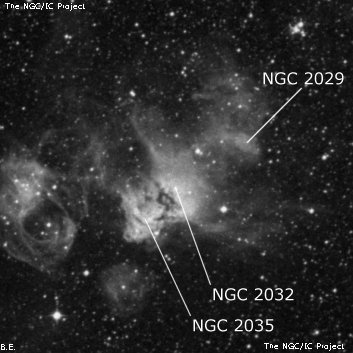
James Dunlop discovered NGC 2032 = D 219 on 27 Sep 1826 and described a "pretty bright round nebula, about 1 1/4' diameter, bright towards the centre." He states 2 observations were made and his published position is within the Seagull Nebula complex. As NGC 2032 is probably the brightest section along with NGC 2035, this identification seems reasonable. Herschel gave an uncertain equivalence with D 219 in his CGH catalogue. He first observed the nebula (h2913) on 2 Nov 1834 and recorded "vB; vL. A singular figure like 3 nebulae lumped together." On a second sweep he recorded "pB; irreg fig; glbM." On his next observation he logged "B; L; gbM. The second of 3 which run together." A detailed sketch of the complex was published in plate III, figure 5 in the CGH observations.
The Seagull Nebula contains four separate NGC designations: NGC 2030 (misidentified as NGC 2029 in GC and NGC), NGC 2032, NGC 2035 and NGC 2040 with NGC 2035 being the brightest and largest of the group. Collectively the area is known as N59A and is located at the boundary of the supershell LMC4 in the Large Magellanic Cloud. NGC 2032 and 2035, which form the bright core of the H II region N59A (B053530- 6736), belong to a single H II region that appears divided due to the presence of a heavy dust lane.
600/800mm - 24" (4/11/08 - Magellan Observatory, Australia): this is possibly the brightest section of the "Seagull Nebula" or "Dragon's Head Nebula" in the LMC (similar to NGC 2035 1.6' SE). It consists of a very bright, elongated ~SSW-NNE patch, 2'x1', with an unusual kidney-bean shape that is indented or concave on the east side. NGC 2032 is just separated to 2035 by an elongated dark lane (oriented SSW-NNE) on the east side. A faint, thin streamer of nebulosity shoots to the north from 2032. Mag 11.4 HD 269808 is off the SW side.
Notes by Steve Gottlieb